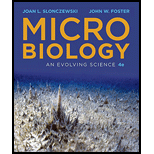
Concept explainers
To review:
The major features of bacterial cells and reveal the ways by which a single cell performs all its functions.
Introduction:
A cell serves as a constituting as well as a functional unit of all life forms that are present on Earth. The level of organization of the cells is also varied in the living world. The cells are comprised of various parts and these parts are constituted by a range of
Bacteria are considered prokaryotes because they do not possess ribosomes, plasma membrane, cytoplasm, and a membrane encircled nucleus. A bacterial cell does not possess well-defined membrane-bounded organelles. They possess a relatively small genome that is highly condensed. Ribosomes are also present in the cytoplasm of the bacterial cell. Various bacterial cells possess a range of organelles depending upon their genus or species.
The bacterial cells usually possess a cell wall. The cell wall is associated with the protection of a bacterial cell and maintains the connection with nearby cells. The macromolecules and proteins that are present in the bacterial cytoplasm maintain the ions and the nutrient level in the cell. The cell wall material controls cytoplasmic expansion and keeps the cell membrane undamaged during water flow.
Explanation of Solution
Bacteria are considered prokaryotes because they do not possess ribosomes, plasma membrane, cytoplasm, and a membrane encircled nucleus. A bacterial cell does not possess well-defined membrane-bounded organelles. They possess a relatively small genome that is highly condensed. Ribosomes are also present in the cytoplasm of the bacterial cell. Various bacterial cells possess a range of organelles depending upon their genus or species.
The bacterial cells usually possess a cell wall. The cell wall is associated with the protection of a bacterial cell and maintains the connection with nearby cells. The macromolecules and proteins that are present in the bacterial cytoplasm maintain the ions and the nutrient level in the cell. The cell wall material controls cytoplasmic expansion and keeps the cell membrane undamaged during water flow.
Want to see more full solutions like this?
Chapter 3 Solutions
Microbiology: An Evolving Science (Fourth Edition)
- Not part of a graded assignment, from a past midtermarrow_forwardNoggin mutation: The mouse, one of the phenotypic consequences of Noggin mutationis mispatterning of the spinal cord, in the posterior region of the mouse embryo, suchthat in the hindlimb region the more ventral fates are lost, and the dorsal Pax3 domain isexpanded. (this experiment is not in the lectures).a. Hypothesis for why: What would be your hypothesis for why the ventral fatesare lost and dorsal fates expanded? Include in your answer the words notochord,BMP, SHH and either (or both of) surface ectoderm or lateral plate mesodermarrow_forwardNot part of a graded assignment, from a past midtermarrow_forward
- Explain in a flowcharts organazing the words down below: genetics Chromosomes Inheritance DNA & Genes Mutations Proteinsarrow_forwardplease helparrow_forwardWhat does the heavy dark line along collecting duct tell us about water reabsorption in this individual at this time? What does the heavy dark line along collecting duct tell us about ADH secretion in this individual at this time?arrow_forward
 Biology (MindTap Course List)BiologyISBN:9781337392938Author:Eldra Solomon, Charles Martin, Diana W. Martin, Linda R. BergPublisher:Cengage Learning
Biology (MindTap Course List)BiologyISBN:9781337392938Author:Eldra Solomon, Charles Martin, Diana W. Martin, Linda R. BergPublisher:Cengage Learning Concepts of BiologyBiologyISBN:9781938168116Author:Samantha Fowler, Rebecca Roush, James WisePublisher:OpenStax College
Concepts of BiologyBiologyISBN:9781938168116Author:Samantha Fowler, Rebecca Roush, James WisePublisher:OpenStax College Human Biology (MindTap Course List)BiologyISBN:9781305112100Author:Cecie Starr, Beverly McMillanPublisher:Cengage Learning
Human Biology (MindTap Course List)BiologyISBN:9781305112100Author:Cecie Starr, Beverly McMillanPublisher:Cengage Learning Biology 2eBiologyISBN:9781947172517Author:Matthew Douglas, Jung Choi, Mary Ann ClarkPublisher:OpenStax
Biology 2eBiologyISBN:9781947172517Author:Matthew Douglas, Jung Choi, Mary Ann ClarkPublisher:OpenStax Biology Today and Tomorrow without Physiology (Mi...BiologyISBN:9781305117396Author:Cecie Starr, Christine Evers, Lisa StarrPublisher:Cengage Learning
Biology Today and Tomorrow without Physiology (Mi...BiologyISBN:9781305117396Author:Cecie Starr, Christine Evers, Lisa StarrPublisher:Cengage Learning





